Podcast
Questions and Answers
Which factor would most likely decrease the solubility of a nonpolar solute in a nonpolar solvent?
Which factor would most likely decrease the solubility of a nonpolar solute in a nonpolar solvent?
- Increasing the size of the solute particles
- Adding ions to the solution
- Increasing the temperature
- Decreasing the temperature (correct)
What effect does increasing the surface area to volume ratio of a solute have on its solubility?
What effect does increasing the surface area to volume ratio of a solute have on its solubility?
- Decreases solubility
- No effect on solubility
- Forms a precipitate
- Increases solubility (correct)
Which statement accurately describes the behavior of solubility for most substances as temperature increases?
Which statement accurately describes the behavior of solubility for most substances as temperature increases?
- Solubility increases (correct)
- Solubility precipitates
- Solubility decreases
- Solubility remains constant
How does the addition of ions affect the solubility of a compound?
How does the addition of ions affect the solubility of a compound?
Which law states that the partial pressure of a substance in a solution is proportional to its mole fraction in the solution and its vapor pressure in its pure state?
Which law states that the partial pressure of a substance in a solution is proportional to its mole fraction in the solution and its vapor pressure in its pure state?
What happens to the solubility of most substances as temperature increases?
What happens to the solubility of most substances as temperature increases?
Which principle summarizes the effect of temperature on solubility?
Which principle summarizes the effect of temperature on solubility?
Apart from temperature, what other factor can influence solubility?
Apart from temperature, what other factor can influence solubility?
Which law describes the relationship between vapor pressure and solute concentration in a solution?
Which law describes the relationship between vapor pressure and solute concentration in a solution?
What does the solubility product constant describe?
What does the solubility product constant describe?
Flashcards are hidden until you start studying
Study Notes
Solubility: Unraveling the Impact of Temperature and Factors
In everyday life, you might have noticed that sugar dissolves more quickly in hot water compared to cold water, or that a soda fizzes less when chilled. These observations stem from the concept of solubility, a property that governs how substances mix with other substances in a solution. In this article, we'll delve into the effects of temperature on solubility, factors that influence solubility, solubility curves, the solubility product constant, and the Raoult Law and Henry Law.
Temperature and Solubility
As temperature rises, the solubility of most substances increases, while the solubility of others decreases. This trend can be summarized by Le Chatelier's principle, which states that if a system at equilibrium is subjected to a change in conditions, the system will adjust to counteract the change. In the case of solubility, higher temperatures lead to a higher rate of molecular motion, which helps substances dissolve more easily. However, this rule doesn't apply to all substances, and some, like gases, exhibit decreased solubility at higher temperatures.
Factors Affecting Solubility
Besides temperature, solubility is influenced by various factors. For instance, the size and shape of solute particles, the polarity of the solvent, and the presence of other substances, such as ions, can all affect solubility.
- Solute particle size and shape: Smaller solute particles have a higher surface area to volume ratio, which makes them easier to dissolve.
- Solvent polarity: Nonpolar solutes dissolve more easily in nonpolar solvents, while polar solutes dissolve more easily in polar solvents.
- Presence of ions: The addition of ions can affect solubility by competing for the solvent molecules or causing common ion effects.
Solubility Curves
A solubility curve is a graphical representation of the relationship between temperature and solubility. As temperature increases, the solubility of most substances increases, and a solubility curve will typically show this pattern. However, for some substances, the solubility might decrease with increasing temperature, and the solubility curve will exhibit the opposite trend. The shape of a solubility curve can help chemists understand the behavior of a substance at different temperatures.
Solubility Product Constant
The solubility product constant (Ksp) is a thermodynamic quantity used to describe the equilibrium between a solid or solid phases and their dissolved ions in solution. It is a quantitative measure of solubility for sparingly soluble ionic compounds. The Ksp is a useful tool for predicting the solubility of ionic compounds under various conditions. For example, the solubility of a compound can be increased by adding a common ion or by changing the pH of the solution.
Raoult Law and Henry Law
The Raoult Law and Henry Law describe the vapor pressure of solutions. The Raoult Law applies to ideal solutions, while the Henry Law applies to dilute solutions of non-volatile solutes in volatile solvents.
- Raoult Law: The Raoult Law states that the partial pressure of a substance in a solution is equal to the product of its mole fraction in the solution and its vapor pressure in its pure state.
- Henry Law: The Henry Law states that the solubility of a gas in a solution is proportional to the pressure of the gas above the solution, provided that the concentration of the gas in the solution is small compared to the concentration of the solvent.
Conclusion
Solubility is a fundamental concept in chemistry, as it determines how substances mix and separate in solutions. By understanding the effects of temperature and various factors, as well as solubility curves, the solubility product constant, and the Raoult Law and Henry Law, chemists can predict the behavior of substances in solutions and apply this knowledge to a wide range of practical applications.
Studying That Suits You
Use AI to generate personalized quizzes and flashcards to suit your learning preferences.




